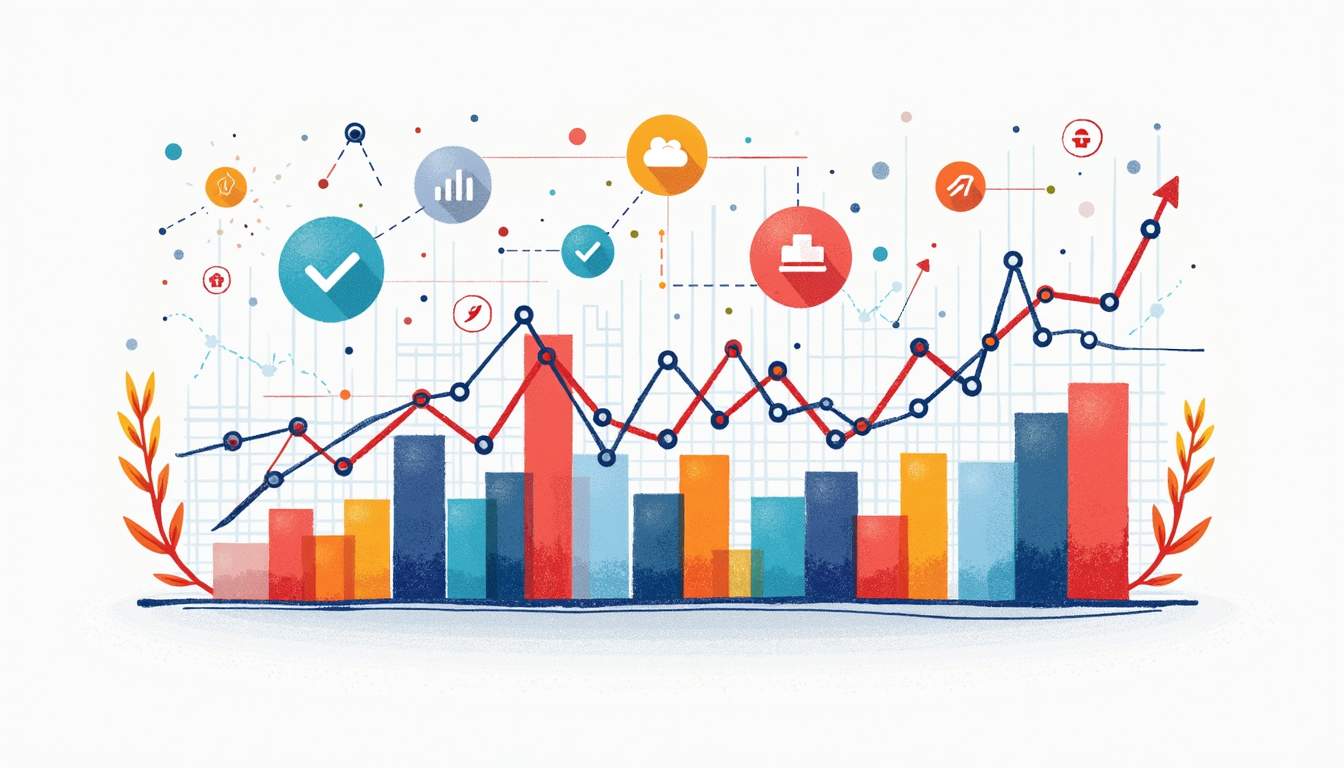The dynamic world of business demands acute awareness and understanding of varying metrics that can make or break a company. Analyzing sales data effectively is paramount to driving profit maximization, allowing businesses to strategically steer towards sustainable growth and competitive advantage. This guide provides a comprehensive approach to leveraging sales data to enhance revenue and profitability.
Understanding the Importance of Sales Data Analysis
In the era of digital transformation, sales data analysis has become a cornerstone in business strategy formulation. By unlocking insights from historical transactions and current sales trends, organizations can make informed decisions that drive business success. Ignoring data patterns and relying solely on intuition can leave potential profits unclaimed.
The Role of Sales Data in Business Growth
Sales data is not just numerical figures; it’s the story of your business. It reveals customer preferences, successful product mixes, and pinpoint areas needing improvement. Continuous analysis of this data leads to smarter marketing strategies, efficient resource allocation, and enhanced product development.
Businesses grow by building on their successes and learning from past outcomes. A thorough understanding of sales data can transform a reactive business culture into a proactive one, boosting resilience in a competitive market. For instance, by analyzing customer purchase patterns, companies can identify seasonal trends that inform inventory management, ensuring that popular products are always available when demand peaks. This not only enhances customer satisfaction but also minimizes lost sales opportunities.
Key Metrics to Monitor for Profit Maximization
Monitoring the right metrics is crucial. Key performance indicators such as sales conversion rates, average transaction size, customer retention rates, and sales cycle length offer valuable insights. Each metric provides a unique glimpse into different facets of the sales process and overall business health.
Analyzing these metrics helps managers identify not just current trends but future opportunities as well. Understanding the financial impacts of these metrics allows for better budgeting and forecasting, ultimately leading to profit maximization. For example, tracking customer retention rates can illuminate the effectiveness of loyalty programs and customer service initiatives, guiding businesses to invest in strategies that foster long-term relationships. Additionally, by examining sales cycle length, organizations can streamline their sales processes, reducing the time it takes to convert leads into customers, thereby increasing overall efficiency and revenue generation.
Collecting and Organizing Sales Data
Having robust systems in place to collect and organize sales data ensures that it is both reliable and accessible for analysis. Compiling this data from various channels, including online transactions, POS systems, and CRM platforms, requires consistency and precision. The importance of this process cannot be overstated; accurate sales data not only informs business decisions but also drives strategic planning and forecasting. By establishing a clear methodology for data collection, businesses can enhance their operational effectiveness and ultimately improve their bottom line.

Sources of Sales Data
Sales data can be sourced from multiple touchpoints. Online transactions, customer feedback forms, and social media interactions provide diverse data inputs. Furthermore, internal records including invoices and order histories augment this external data, creating a comprehensive dataset. Each source contributes unique insights; for instance, online transactions might reveal purchasing trends, while customer feedback can highlight areas for service improvement. Additionally, tracking social media interactions allows businesses to gauge brand sentiment and customer engagement, which are critical for tailoring marketing strategies.
It’s essential to integrate these data sources seamlessly to maintain data integrity. This integration allows for a holistic view of the sales cycle, offering qualitative and quantitative insights into customer preferences and operational efficiency. By employing techniques such as data normalization and deduplication, businesses can ensure that the data they analyze is not only accurate but also relevant. This comprehensive approach to data collection enables organizations to identify patterns and correlations that might otherwise go unnoticed, ultimately leading to more informed decision-making.
Tools for Data Collection and Management
Utilizing advanced tools for data collection and management is vital in today’s data-centric business environment. Software solutions ranging from Customer Relationship Management (CRM) systems to data analytics platforms facilitate efficient data handling. These tools help convert raw data into actionable insights, allowing businesses to respond swiftly to market changes and customer needs. Moreover, the integration of artificial intelligence and machine learning in these tools can further enhance data analysis, predicting trends and automating routine tasks, thereby freeing up valuable human resources for more strategic initiatives.
Choosing the right tools depends on the specific needs of the business, whether those are cloud-based solutions for scalability or on-premises software for greater control. With the right tools, businesses can streamline data processes, ensuring accuracy and timeliness. Furthermore, training staff to utilize these tools effectively is crucial; even the most advanced software is only as good as the people operating it. Regular training sessions and updates on new features can empower employees to maximize the potential of the tools at their disposal, fostering a culture of data-driven decision-making throughout the organization.
Techniques for Analyzing Sales Data
Once data is organized, various analytical techniques can be applied to extract meaningful insights. Whether you are examining past sales trends or predicting future outcomes, employing the right methodology is crucial for data-driven decision-making.

Descriptive Analysis for Sales Trends
Descriptive analysis offers a retrospective view of sales data to understand what occurred in past periods. By utilizing charts, graphs, and summary statistics, companies can visually and quantitatively assess sales patterns over time.
This type of analysis aids in identifying historical sales trends, whether it’s monthly spikes or annual declines, and assists in laying the groundwork for more advanced analyses. For instance, by segmenting data by product category or geographical region, businesses can uncover specific areas of strength or weakness, allowing for targeted marketing strategies. Additionally, incorporating external factors such as seasonal variations or economic indicators can further enrich the analysis, providing a comprehensive view of the sales landscape.
Predictive Analysis for Future Sales Forecasting
Predictive analysis uses statistical techniques and machine learning models to forecast future sales trends based on historical data. This forward-looking approach helps in anticipating market demands, aligning production schedules, and optimizing supply chain management.
By accurately forecasting future trends, businesses can make strategic decisions that mitigate risks and capture opportunities, ultimately driving profit growth. Moreover, predictive models can be refined over time with new data, enhancing their accuracy and reliability. Companies can also leverage customer behavior analytics, such as purchasing patterns and preferences, to tailor their offerings and marketing efforts, ensuring they meet consumer needs effectively.
Prescriptive Analysis for Strategic Decision Making
Prescriptive analysis goes beyond predictions by suggesting actionable steps based on data insights. This advanced analytical technique considers various scenarios, assisting decision-makers in determining the best course of action for specific business challenges.
Through simulation models and optimization algorithms, prescriptive analysis provides strategic roadmaps, supporting long-term strategic planning and operational enhancements. For example, a retail company might use prescriptive analytics to determine optimal inventory levels across different locations, balancing stock availability with minimizing holding costs. Additionally, integrating prescriptive analysis with real-time data can empower organizations to respond swiftly to market changes, ensuring they remain competitive and responsive to evolving consumer demands.
Identifying Patterns and Trends
Recognizing patterns and trends within sales data allows businesses to capitalize on opportunities and address potential pitfalls. By meticulously studying the data, companies can fine-tune their strategies for maximum effectiveness and efficiency. This analytical approach not only aids in immediate decision-making but also lays the groundwork for long-term strategic planning, enabling businesses to stay ahead of the competition in an ever-evolving marketplace.

Seasonal Sales Variations
Seasonality is a critical aspect of sales analysis, as consumer behavior often varies with seasons. Identifying and understanding these seasonal patterns allow businesses to plan marketing campaigns and inventory management accordingly. For instance, retail businesses often see spikes in sales during holiday seasons, while certain products may experience lower demand during off-peak times. By leveraging historical sales data, companies can anticipate these fluctuations and prepare targeted promotions that resonate with consumers during peak shopping periods.
Businesses that adapt their strategies to accommodate these variations can better manage cash flow and inventory levels, thereby improving customer satisfaction and profitability. Additionally, recognizing emerging seasonal trends can provide a competitive edge; for example, a company that identifies a growing interest in eco-friendly products during a specific season can quickly pivot to highlight these offerings, attracting environmentally conscious consumers and maximizing sales opportunities.
Customer Buying Behavior Analysis
Analyzing customer buying behavior provides invaluable insights into customer preferences and purchasing motives. This analysis helps identify loyal customers, high-value segments, and emerging trends in customer demands. By segmenting customers based on their buying habits, businesses can create personalized marketing strategies that resonate more deeply with each group. For example, a company might discover that a particular demographic prefers online shopping over in-store experiences, prompting them to enhance their e-commerce platform and tailor promotions specifically for that audience.
By understanding these behavioral patterns, businesses can tailor their product offerings, marketing messages, and sales strategies to better meet customer needs, enhancing customer retention and driving sales growth. Furthermore, leveraging advanced analytics tools can provide real-time insights into customer behavior, allowing businesses to swiftly adapt to changing preferences and market dynamics. This proactive approach not only fosters stronger customer relationships but also positions companies to innovate and introduce new products that align with evolving consumer expectations.
Leveraging Data for Strategic Decisions
Data-driven decisions can significantly enhance strategic planning and operational efficiency. By leveraging detailed sales data insights, companies can make informed decisions that align with their long-term objectives.
Pricing Strategy Optimization
Optimal pricing strategies are crucial for maximizing profits and ensuring competitive positioning. Through detailed analysis of sales data, businesses can identify the ideal price points that drive both volume and profit.
Dynamic pricing strategies, informed by real-time data, also allow businesses to adjust prices in response to market conditions, ensuring they capture maximum value from each transaction.
Inventory Management and Demand Forecasting
Effective inventory management relies on accurate demand forecasting. Sales data analysis provides the foundation for predicting future demand, enabling businesses to maintain optimal inventory levels and reduce holding costs.
Streamlined inventory management ensures product availability, minimizes stockouts, and reduces overstock situations, supporting a responsive and cost-effective supply chain.
In conclusion, analyzing sales data with a strategic focus on profit maximization enables businesses to unlock new opportunities, streamline operations, and secure a competitive edge in the marketplace. From understanding customer behavior to optimizing pricing strategies, the benefits of data-driven decision-making are limitless. Implementing a robust data analysis framework is not just an option—it’s a necessity in today’s market environment.
Maximize Your Hotel’s Revenue with Prosper Hotels
Ready to take your hotel’s profit to the next level? At Prosper Hotels, we specialize in transforming data into revenue. Our tailored revenue management strategies, innovative digital marketing, and streamlined group housing services are designed to elevate your hotel’s performance. Embrace the power of data-driven decision-making with our expert team and watch your revenue soar. Don’t miss out on the opportunity to enhance your hotel’s success. Learn More about how we can help you achieve your goals.


 Drive More Hotel Revenue
Through Untapped Strategies
Drive More Hotel Revenue
Through Untapped Strategies
